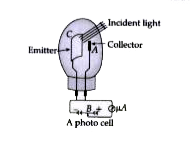The dissociation of (molecular) chlorine is an endothermic process, ΔH=243.6kJmol−1. The disoociation can also attained by the effect of light.
Can this effect also be obtained with light whose wavelength is smailer or larger than the calculayed critical wavelength?
The correct Answer is:Short-wave light is effective, as its photons have a greater than required whereas the photon of longer-wavelength light are too poor in energy to affect the dissociation.
Similar Questions
The dissociation of (molecular) chlorine is an endothermic process, ΔH=243.6kJmol−1. The disoociation can also attained by the effect of light.
What is the energy of the photon with the critical wavelength?
View SolutionThe dissociation of (molecular) chlorine is an endothermic process, ΔH=243.6kJmol−1. The disoociation can also attained by the effect of light.
At what wavelength can the dissociating effect of light be expected?
View Solution
Knowledge Check
The energy required to ionize a potassium ion is 419 kJ mol−1 . What is the longest wavelength of light that can cause this ionization ?
A285 nmB216 nmC200 nmD107 nmRead the following text and answer the following questions on the basis of the same
Photocell: A photocell is a technological application of the photoelectric effect. It is a device whose electrical properties are affected by light. It is also sometimes called an electric eye. A photocell consits of a semi-cylindrical photo-sensitive metal plate C(emitter) and a wire loop A (collector) supported in an evacuated glass or quartz bulb. It is connected to the external circuit having a high tension battery B and micro ammeter (μA) as shown in the Figure.

Sometimes, instead of the plate C, a thin layer of photoensitive material is pasted on the inside of the bulb. A part of the bulb is left clean for the light to enter it. when light of suitable wavelength falls on the emitter C, photoelectrons are emitted. These photoelectrons are drawn to the collect A. Photocurrent of the order of a few microampere can be normally obtained from a photo cell. A photocell converts a change in intensity of illumination into a change in photocurrent. This current can be used to operate control system and in light measuring devices.
Photocell is an application ofAthermoelectric effectBphotoelectric effectCphotoresistive effectDNone of the above
The dissociation of (molecular) chlorine is an endothermic process, ΔH=243.6kJmol−1. The disoociation can also attained by the effect of light.
At what wavelength can the dissociating effect of light be expected?
View SolutionThe dissociation of (molecular) chlorine is an endothermic process, ΔH=243.6kJmol−1. The disoociation can also attained by the effect of light.
How can the value obtained be (qualitatovely) explained? Describe the reaction mechanism.
View SolutionThe dissociation of (molecular) chlorine is an endothermic process, ΔH=243.6kJmol−1. The disoociation can also attained by the effect of light.
How can the value obtained be (qualitatovely) explained? Describe the reaction mechanism.
View SolutionThe dissociation of (molecular) chlorine is an endothermic process, ΔH=243.6kJmol−1. The disoociation can also attained by the effect of light.
How large is the quantum yield (=the number of product molecules per absorbed photons)?
View SolutionThe dissociation of (molecular) chlorine is an endothermic process, ΔH=243.6kJmol−1. The disoociation can also attained by the effect of light.
How large is the quantum yield (=the number of product molecules per absorbed photons)?
View SolutionThe dissociation of (molecular) chlorine is an endothermic process, ΔH=243.6kJmol−1. The disoociation can also attained by the effect of light.
What is the energy of the photon with the critical wavelength?
When light that can effect the chlorine dissociation is incident on a mixture of gaseous chlorine and hydrogen, hydrogen chloride is formed. The mixture is irradiated with a mercury UV-lamp (ë=253.6 nm). The lamp has a power input of 10W. An amount of 2% of the energy supplied is absorbed by the gas mixture (in a 10 litre vessel). Withn 2.5 seconds of irradiation 65 millomoles of HCl are formed.
View Solution
